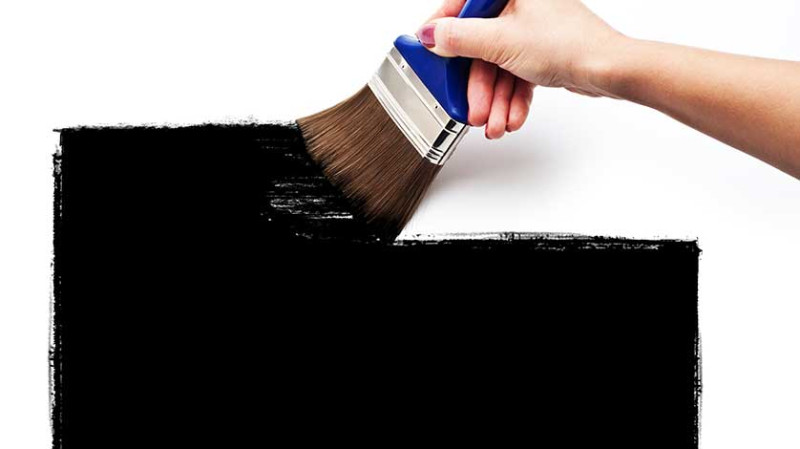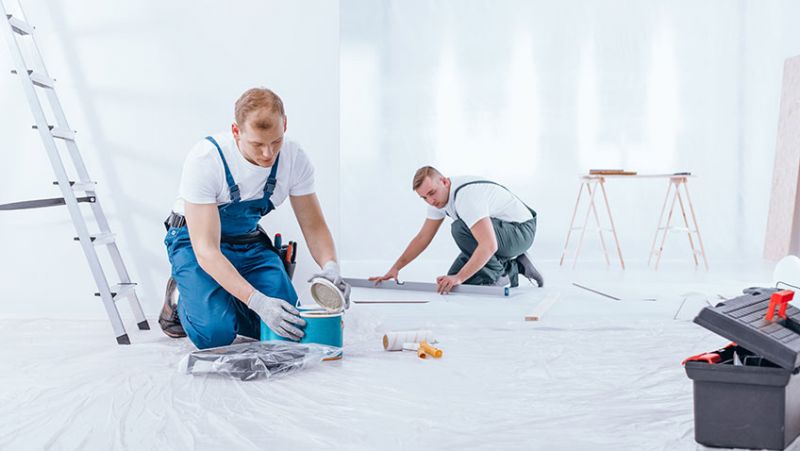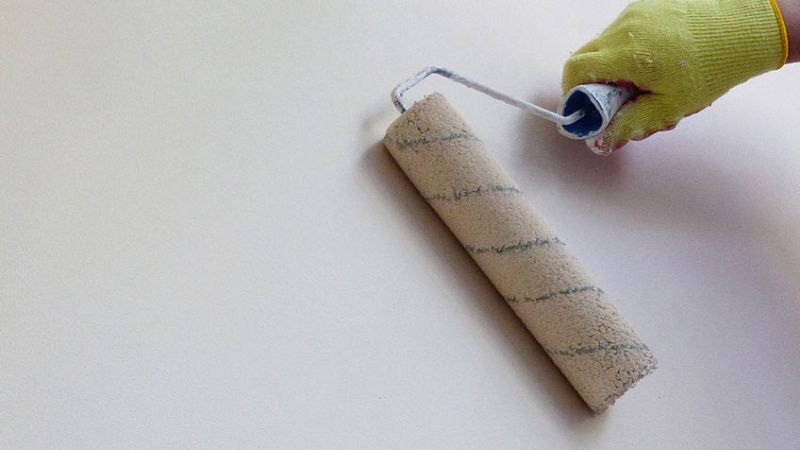
Whether you're a homeowner looking to refresh your living space, a professional designer hunting for inspiration, or a tradesperson seeking creative ideas for clients, adding colour to your walls is one of the easiest and most effective ways to transform any room. Colour not only enhances the mood of a space but also reflects your personal style, creating an atmosphere that’s unique to you.
From bold paint choices to eye-catching decorative finishes, there are countless ways to bring vibrancy and energy into your home. Whether you're working with a small room or an expansive open-plan space, there are techniques to suit every size and style.
In this post, we’ll explore nine creative and practical ways to add a splash of colour to your walls — perfect for British homes. Let’s dive in!
1. Accent Walls
One of the most effective and straightforward ways to introduce colour into a room without overwhelming the space is by creating an accent wall. This approach allows you to experiment with bold, statement-making shades while keeping the overall feel of the room balanced. Choose a rich, deep tone like navy blue, forest green, or a warm burgundy — colours that work particularly well in traditional British homes with classic architectural features. These hues bring a sense of depth and sophistication without dominating the room.
To create a striking contrast, pair your accent wall with neutral tones, such as whites, greys, or soft beige, which will allow the accent wall to pop. Alternatively, you can enhance the look by incorporating complementary soft furnishings, such as cushions, throws, or curtains, that mirror the accent colour. This ties the entire room together, creating a cohesive and well-thought-out design. Accent walls are perfect for those who want to add personality and a touch of drama to their home, without the commitment of painting the entire room in a bold colour.
2. Two-Tone Painting
If you're looking for a way to add a touch of colour and sophistication to your walls while maintaining a balanced aesthetic, two-tone painting is a fantastic choice. This technique involves splitting your wall into two horizontal sections, each painted in a different colour. The result is a striking visual effect that adds interest and structure to the room. Two-tone painting is incredibly versatile and can be adapted to various spaces, from living rooms to hallways and children's bedrooms. It’s a great way to bring in colour without overwhelming the room, offering a modern yet timeless look.
For a classic British look, consider pairing a muted pastel shade like soft lavender or powder blue with a crisp white or light grey. This combination creates a serene, airy feel perfect for living rooms or hallways. Alternatively, for a more dramatic effect, choose a deep heritage colour such as navy blue, forest green, or charcoal, and pair it with a neutral beige or greige on the lower half of the wall. This contrast adds a touch of depth and elegance, making the room feel more grounded while maintaining a sense of freshness and openness.
The key to achieving a crisp, professional finish with this technique is using painter’s tape to create a sharp, straight line where the two colours meet. This ensures the division is clean and precise, giving your room a polished, high-quality appearance. You can experiment with different colour combinations to suit the mood of the room — light, fresh colours for a calm, tranquil space or bolder shades for an energising, dynamic environment. Two-tone painting offers a simple yet impactful way to introduce colour to your walls, allowing you to express your style with flair and creativity.
3. Wall Panelling with Colour Contrast
Wall panelling is a timeless design element that has been making a significant comeback in British interiors, seamlessly blending traditional elegance with modern flair. From classic Edwardian homes to sleek new builds, panelling can add texture, depth, and character to any room. One of the best ways to elevate this style is by using contrasting colours on the panelled lower section of the wall, creating a striking contrast with the upper wall. This not only draws the eye but also enhances the architectural features of the room.
For example, imagine a dark green panel beneath a pale cream or soft white upper wall. This combination gives a modern twist to traditional panelling, infusing the room with warmth and sophistication. The darker panel contrasts beautifully with the lighter wall, adding visual interest while maintaining a sense of balance. It’s a perfect way to make the panelling stand out as a statement feature, all while creating a harmonious flow throughout the room. Whether you’re aiming for a more classic or contemporary look, this technique works in a variety of spaces, from formal dining rooms to cosy living rooms or even stylish home offices.
The beauty of this technique is in its versatility — you can experiment with different colour pairings to achieve a look that reflects your personal style. If you prefer a more subtle contrast, consider pairing muted shades such as deep grey with a soft taupe. For a bolder, more dramatic effect, combine rich hues like navy blue with a light, neutral shade. It’s important to ensure that the colours you choose complement each other, so the overall aesthetic feels cohesive. Wall panelling with colour contrast not only brings a touch of luxury to your home but also adds depth and dimension to your walls, creating an inviting and sophisticated atmosphere.
4. Wallpaper Feature Walls
Wallpaper is an incredibly versatile design tool that offers a broad spectrum of patterns, textures, and finishes to create a striking feature wall in any room. Whether you're aiming for a bold, vibrant look or a more subtle, textured aesthetic, wallpaper can completely transform the atmosphere of a space. A feature wall made of wallpaper can serve as the focal point of the room, adding depth, personality, and visual interest without overwhelming the rest of the decor.
One of the most popular choices for creating a feature wall is florals, which are perfect for achieving a warm, inviting countryside cottage feel. Soft floral prints in pastel hues can instantly add charm and character to a bedroom or living room, bringing a touch of nature indoors. On the other hand, if you prefer a more modern and edgy vibe, geometric patterns are an excellent choice. Clean lines, bold shapes, and contrasting colours can give your space a contemporary flair, making them ideal for more urban settings or minimalist interiors. For those looking to make a bold statement, metallic finishes are an exciting option. A wallpapered feature wall with shimmering gold, silver, or bronze accents can introduce a layer of glamour and sophistication to any room.
The beauty of a wallpaper feature wall is its ability to draw the eye without overpowering the room. Positioning wallpaper behind a bed in the bedroom or a sofa in the living room creates an instant focal point, giving your space a designer touch. By keeping the rest of the walls neutral, the wallpapered wall can stand out as the centrepiece, adding dimension and style. Additionally, wallpaper with textured finishes, like linen or silk, can enhance the tactile experience of the room, making it feel richer and more inviting.
When selecting a wallpaper for a feature wall, consider the size and layout of your space. In smaller rooms, lighter patterns or subtle textures work best to avoid the room feeling cramped. For larger spaces, you can experiment with more intricate designs or bolder colours to make a statement. Whichever direction you choose, a wallpaper feature wall is an excellent way to infuse your personality into your home, creating an inviting and memorable environment.
5. Mural or Hand-Painted Designs
If you're looking for a creative way to infuse your space with personality and style, a hand-painted mural or stencilled design can be a truly unique addition to your walls. This technique allows you to showcase your artistic flair, turning a plain wall into a canvas for self-expression. Whether you're inspired by nature, abstract art, or urban landscapes, the possibilities for hand-painted designs are virtually endless. A mural can create a one-of-a-kind atmosphere in any room, adding depth, character, and a sense of artistry that instantly elevates your interior design.
Abstract shapes and patterns are a popular choice for those looking to bring a modern, artistic vibe to their home. Bold geometric designs or fluid, organic shapes can transform a blank wall into a focal point, adding visual interest and texture to the space. For a more serene and natural look, botanical themes—such as painted vines, leaves, or flowers—are perfect for bringing a touch of nature indoors. These designs can soften the atmosphere of a room, creating a calming, peaceful environment that's perfect for spaces like bedrooms or living rooms.
One of the most exciting aspects of hand-painted murals is the opportunity to create something truly custom. Imagine a skyline silhouette for a dramatic city-inspired look, or a whimsical landscape that transports you to a different world. These designs can be tailored to reflect your personal style, interests, and the mood you want to evoke in the room. Whether you’re painting the entire wall or just a portion of it, a mural can serve as a stunning conversation starter and a beautiful focal point that draws the eye.
If freehand painting isn't your strong suit, don’t worry! There are plenty of alternatives that still allow you to add artistic flair to your walls. Pre-cut stencils are a fantastic option for creating detailed designs without the pressure of freehand painting. You can use them to create intricate patterns, shapes, or even themed illustrations. Wall decals are another great DIY-friendly option—these removable designs come in various styles, from modern geometric patterns to playful, nature-inspired motifs. They’re especially great for renters or anyone who wants the flexibility to change their wall designs without committing to a permanent paint job.
Whether you opt for a full mural, a series of smaller designs, or decorative stencils, hand-painted designs and murals offer a wonderful way to make a bold, personal statement in your home. This is your opportunity to let your creativity shine and make your walls an unforgettable part of your home’s decor.
6. Decorative Paint Finishes
If you’re looking to elevate the texture and depth of your walls, decorative paint finishes are an excellent way to add character and visual interest to a room. Techniques like colour washing, rag rolling, and sponge painting can transform flat surfaces into works of art, giving your walls a distinctive, textured look. These finishes are particularly well-suited for creating a rustic, vintage, or Mediterranean aesthetic, making them perfect for period properties or homes that embrace a more eclectic or timeless style.
Colour washing is a beautiful technique that involves applying a thin, translucent layer of paint over a base coat, creating a soft, muted effect that adds a subtle depth and complexity to the wall. This finish works well with earthy tones, such as soft greys, terracotta, and warm neutrals, and is often used to replicate the look of aged plaster. For a more dramatic effect, you can experiment with contrasting colours to create a more striking appearance. This technique is ideal for creating an elegant, lived-in feel, especially in spaces like living rooms, dining rooms, or even hallways.
Rag rolling, on the other hand, creates a slightly more pronounced texture. It involves using a rag to roll the paint in a pattern across the surface, creating a rich, marbled effect. This technique is great for adding a sense of grandeur and can work particularly well with jewel tones like deep purple, emerald green, or gold accents. For a softer, subtler look, consider using lighter shades or tonal variations of the same colour to achieve a more understated, sophisticated result.
Sponge painting is another popular method that brings a beautiful, textured finish to walls. It involves applying a glaze or top coat using a sponge to create a soft, textured effect. This technique is often used to achieve a more relaxed, Mediterranean or shabby-chic look, especially when combined with warm, sun-drenched colours such as pale yellow, peach, or soft blue. Sponge painting can also be applied in layers, allowing you to adjust the intensity of the texture to suit the room's vibe. It’s an excellent choice for living rooms, kitchens, or any space where you want to introduce a touch of warmth and visual appeal.
When choosing a decorative paint finish, it’s important to consider the overall style and atmosphere you want to create. For a more subtle effect, stick to tonal variations of one colour to create a sense of depth without overwhelming the space. If you’re looking for a bold statement, experiment with high-contrast hues to add drama and personality to your walls. No matter which technique you choose, decorative paint finishes offer a wonderful way to add texture, richness, and charm to your home’s interior.
7. Painted Ceilings
When it comes to adding a splash of colour to your space, it’s easy to forget about the fifth wall — your ceiling. Painted ceilings are an often-overlooked design element, but they can make a significant impact on the overall mood and feel of a room. By adding colour to your ceiling, you can introduce depth, contrast, and a surprising twist that elevates the entire space.
For a serene, open feeling, try painting your ceiling a soft, pale blue. This hue mimics the sky, making the room feel more expansive and airy. It’s a particularly wonderful choice for bedrooms or living rooms where you want to create a light and tranquil atmosphere. When paired with white walls and light furnishings, a blue ceiling can enhance the sense of openness, making the room feel more connected to the outdoors, even if it’s indoors.
On the other hand, darker shades can create a sense of drama and intimacy. Consider using rich, deep colours like charcoal, navy, or even a dark plum for a cosy and sophisticated look. These tones can make a room feel more intimate and inviting, perfect for spaces like dining rooms, home theatres, or bedrooms. A dark ceiling adds a sense of depth, drawing the eye upward and creating a cocoon-like effect that feels luxurious and comforting.
Painted ceilings are also a great opportunity to play with the architectural features of a room. If you have ornate moulding or a feature such as beams or a vaulted ceiling, consider painting these elements in a contrasting colour to make them stand out. A soft, pale shade on the ceiling paired with a darker colour on the beams can create a striking visual effect that adds character and charm to the room.
If you’re hesitant to go all-in with a bold ceiling colour, start with a subtle accent. Consider painting the trim or moulding around the ceiling in a soft contrast to the walls. This can create a clean, polished look without overwhelming the space. Alternatively, you could use the ceiling colour to complement or match with other colours in the room, such as your furniture, curtains, or even a patterned wallpaper feature wall.
No matter your choice, a painted ceiling is an excellent way to add unexpected character and design flair to a room. Whether you go for a soft pastel to create a calming effect or a bold, dark shade to add drama and warmth, the ceiling offers a unique canvas that can change the entire dynamic of a space. So, why not look up and explore the possibilities?
8. Painted Alcoves or Shelves
Alcoves are a charming feature in many British homes, particularly in Victorian and Edwardian terraced properties, and they offer a fantastic opportunity to add character and colour to your walls. These recessed areas, often found around fireplaces or in living rooms and dining rooms, can sometimes feel like forgotten spaces, but with a little creativity, they can become a focal point of the room.
One of the simplest ways to draw attention to these architectural features is by painting the inside of an alcove in a contrasting or coordinating colour. Whether you choose a deep, bold tone to create a striking contrast with the surrounding walls or a softer, complementary hue to bring harmony to the room, painting the alcove adds an unexpected twist that instantly enhances the space.
For example, a soft, pale shade of blue or green can create a serene, calming effect, making the alcove feel like a cozy nook. This approach works especially well in living rooms or bedrooms, where you might want to create a space for reading or displaying personal items. On the other hand, rich colours like navy, charcoal, or deep burgundy can give the alcove a more dramatic look, ideal for showcasing artwork, sculptures, or treasured collections.
Another popular technique is to use a lighter shade for the alcove’s interior and pair it with a darker tone on the surrounding wall. This combination can create depth and dimension, making the alcove feel more pronounced and inviting. It also helps to highlight any architectural detailing or custom shelving you may have installed. You can even paint the shelves themselves in the same colour as the alcove’s interior to tie the look together seamlessly.
If your alcove is used for shelving, painting the back wall in a colour that complements the objects displayed on the shelves can bring a sense of cohesion to the room. For instance, a muted grey or soft cream can allow books, decorative items, or plants to stand out without overwhelming the space. Alternatively, a darker hue like deep green or navy can help highlight items on the shelves, giving them a sense of purpose and elegance.
Additionally, painted alcoves work wonderfully in rooms with a lot of natural light, as the colour can reflect and play with the light, adding another dimension to the room’s atmosphere. If you’re hesitant to go bold, start with a neutral or soft shade and gradually experiment with darker or brighter colours as you get more comfortable with the effect.
Whether you choose to create a subtle contrast or a bold statement, painting your alcoves or shelves is an excellent way to enhance the architectural beauty of your home. It’s a quick, easy way to infuse personality into your space and make the most of every nook and cranny.
9. Colour Blocking
Colour blocking is a bold and modern painting technique that can instantly transform a room with its striking visual impact. By using painter’s tape to create sharp, defined geometric shapes or rectangular sections, you can introduce blocks of colour that bring a sense of order and creativity to any space. This technique works especially well in areas where you want to make a statement or introduce some playfulness into the design, such as home offices, hallways, or children's rooms.
One of the key advantages of colour blocking is its versatility. You can use a single wall to create a dynamic focal point, or extend the technique across multiple walls to create a striking, immersive effect. For a cohesive look, choose colours from the same family or tones that complement each other. A combination of soft pastels, such as pale pink and mint green, can create a calm, balanced atmosphere in a living room or bedroom. On the other hand, vibrant hues like deep blue, orange, and yellow can energize a home office or playroom, infusing the space with a fun, energetic vibe.
If you prefer a more minimalist aesthetic, you can opt for a monochromatic approach, where different shades of the same colour are used to create depth and dimension. This subtle version of colour blocking works beautifully in modern interiors, particularly in areas like entryways or feature walls. Pairing light and dark shades of grey, for example, can lend sophistication and create a dramatic visual effect without overwhelming the room.
For a more dramatic, eye-catching approach, try mixing contrasting colours, such as a bold yellow with a deep charcoal or navy. This creates a high-energy, graphic design that commands attention and can make a room feel fresh and contemporary. To achieve this, start by planning out your colour blocks on paper or by using painter’s tape to outline the shapes directly on the wall. When choosing colours, make sure they not only look great together but also align with the overall mood and functionality of the room.
Colour blocking is also a fantastic way to highlight specific areas of a room, such as creating a focal point around a fireplace or defining a workspace within a larger room. This can help visually organize the space and add structure to open-plan layouts, where boundaries between different areas can sometimes feel blurred.
The key to successful colour blocking is ensuring that the lines are crisp and neat. Make sure to use high-quality painter's tape and apply it carefully to achieve clean, defined edges. Once the tape is in place, paint the sections with a roller or brush, and remove the tape while the paint is still slightly wet to avoid peeling.
Whether you go for bold, contrasting colours or a more muted, coordinated palette, colour blocking allows you to express your creativity and personal style in a unique way. It’s an easy and affordable method to bring fresh energy to your walls and turn your living space into a true work of art.
Final Thought
Revamping your walls doesn’t always require a full renovation. With a splash of colour and a little creativity, you can completely refresh the atmosphere of your home. Whether you choose a fresh coat of paint, add panelled depth, or get inventive with artful mural designs, these methods are perfect for DIYers, decorators, and tradespeople alike. A small change in the colour or design of your walls can have a huge impact on the overall feel of the room, giving it a modern update, enhancing its charm, or even creating a cozy, inviting vibe.
The possibilities are endless, and by using the right materials and techniques, you can achieve professional results without breaking the bank. So, don't be afraid to experiment with different styles and finishes that reflect your personality and suit your home’s character.
Looking for quality paints, tools, or expert advice? Visit your local decorating centre or browse our curated online collection to get started today. With the right products and guidance, your wall transformation will be a smooth and enjoyable journey.




